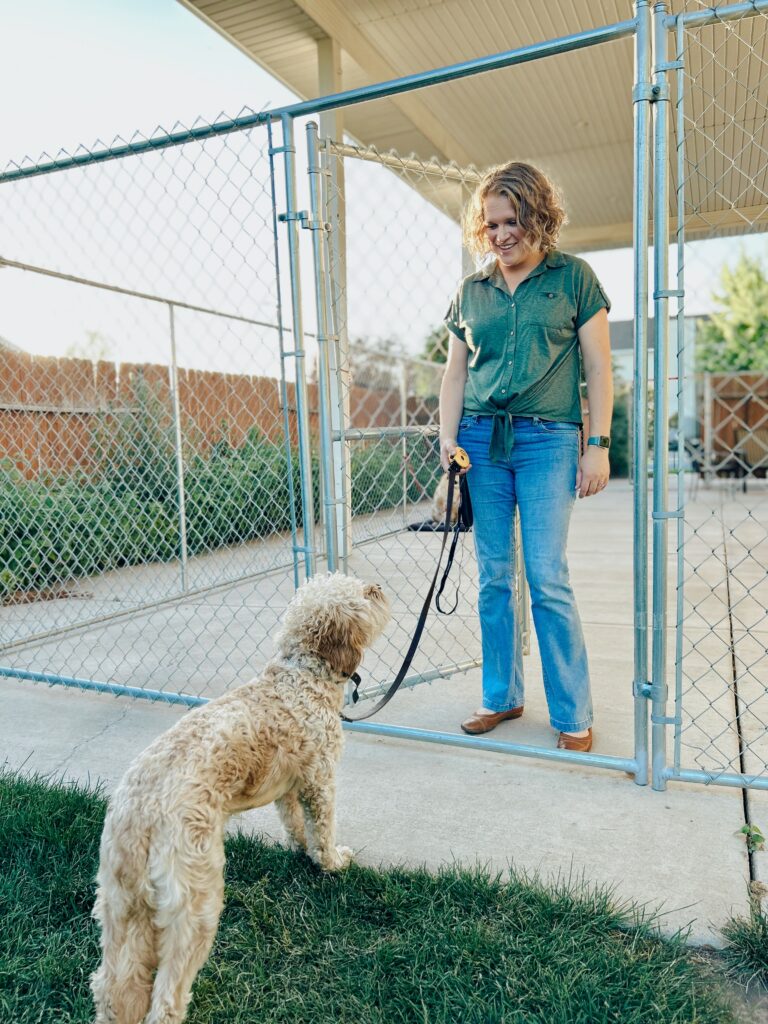“Wait” Vs. “Stay”
Here at Cornerstone Dog Training, we teach our dogs to “wait”. It sounds similar to a “stay” command, but with clearer boundaries. Most people, when asking their dog to “stay”, are not very precise on what they mean. “Wait” is what we use when we want a dog to remain on one side of a* physical* boundary.
Teaching your dog to “wait” is one of the most practical skills you can give them. It’s more than just good manners—it’s a safety net. A reliable wait command can stop your dog from bolting out the front door, charging out of the kennel, or crossing the street before it’s safe.
Why Does it Matter to Teach Your Dog to Stay?
Dogs are naturally curious and impulsive. Without boundaries, they’ll often follow their nose (or their excitement) right into trouble. The wait command builds impulse control and teaches your dog to look to you for permission before moving forward.
Common reasons why we teach your dog to stay behind thresholds are:
- At doors before going outside
- Before crossing a street
- Waiting to exit their kennel
- Holding position at the top or bottom of stairs
- Staying out of certain rooms

Step-by-Step: Teaching the Wait Command
You’ll need:
- A slip lead (for gentle, quick communication)
- A food pouch with small treats or kibble
- A clear boundary (doorway, step, or a strip of painter’s tape if indoors)
1. Set the Stage
Stand with your dog on leash in front of the boundary. Keep the leash loose.
2. Give the Command
Step through the boundary first. Turn to face your dog with the threshold between you and them, and say, “Wait.”
3. Enforce the Line
If your dog’s paw touches or crosses the line, use a quick flick of the leash toward you to guide them back. Avoid pulling—think short, light corrections. Increase the firmness only as needed.
4. Mark and Reward
When your dog stops trying to cross, say “Yes!” and reward with food. Over time, they’ll learn that waiting calmly earns a treat and your approval.
5. Add the Release
Once your dog is consistently holding the wait, get eye contact, say your release word (we like “Okay!”), and step back to invite them across. Keep the leash loose as they pass.
6. Practice in Daily Life
Start with one boundary, then add more situations—doorways, kennel doors, or even an open car hatch. The more consistent you are, the faster your dog will understand that “wait” means “pause until I say go.”
Pro Tips for Success to Teach your dog to Stay:
- Be consistent – Every door or gate is a training opportunity.
- Keep sessions short – A few successful repetitions are better than long, sloppy practice.
- Look for calm – Release only when your dog is still and focused on you.
- Stay patient – Puppies especially may only hold the wait for a second or two at first. That’s okay—build gradually.
Bottom line: A good wait command can make life calmer, safer, and more enjoyable for you and your dog. Start small, use it daily, and celebrate the little wins—before long, you’ll have a dog who stops and looks to you before charging ahead. Teach your dog to stay, using the “wait” command and let us know if you are ready for the next step!
Any Dog, Any Age
Any dog can learn if you teach your dog to stay. However, puppies younger than five months will require more consistency and patience. This doesn’t mean you can’t teach them! In our Puppy Training Program, we will walk you through your first 100 days of puppyhood.
If you don’t have a puppy younger than five months, and the poor habits of running out the door are already in place, we’ve got you covered! Our Chaos to Calm program is right for you.
Don’t know what you need to do next? Schedule a call with one of our trainers, today! It’s FREE! Click here to talk.
Want to know how to teach your dog to stay in their command? Click here to read!
+ show Comments
- Hide Comments
add a comment